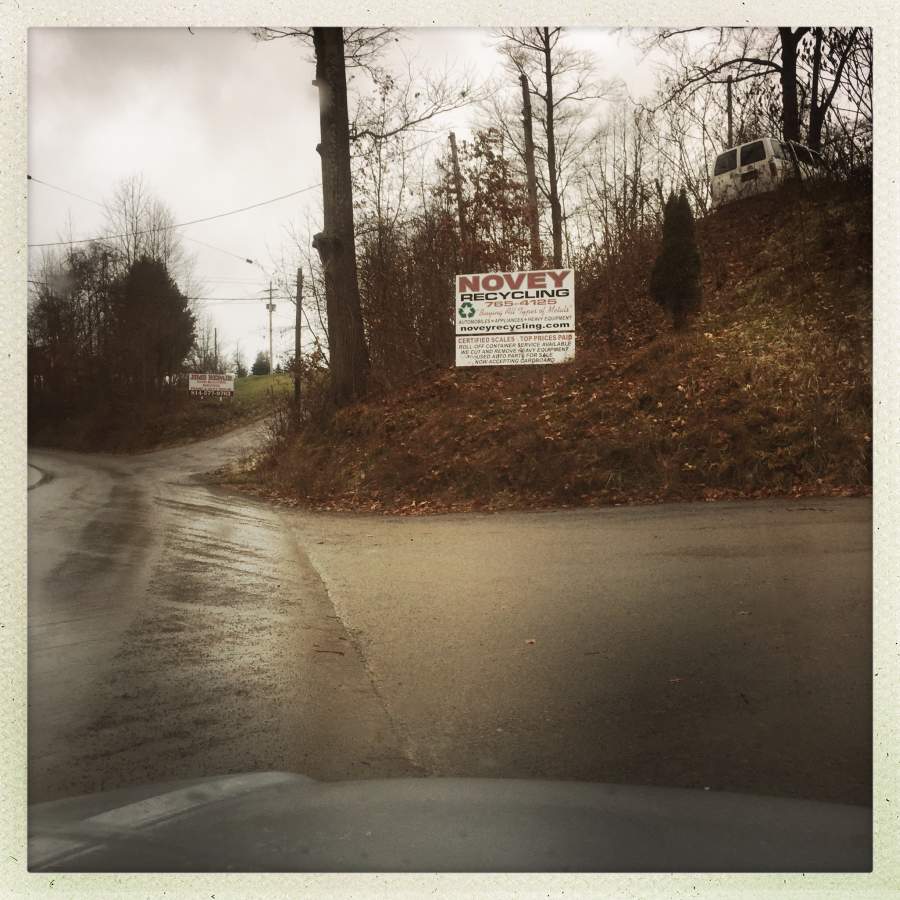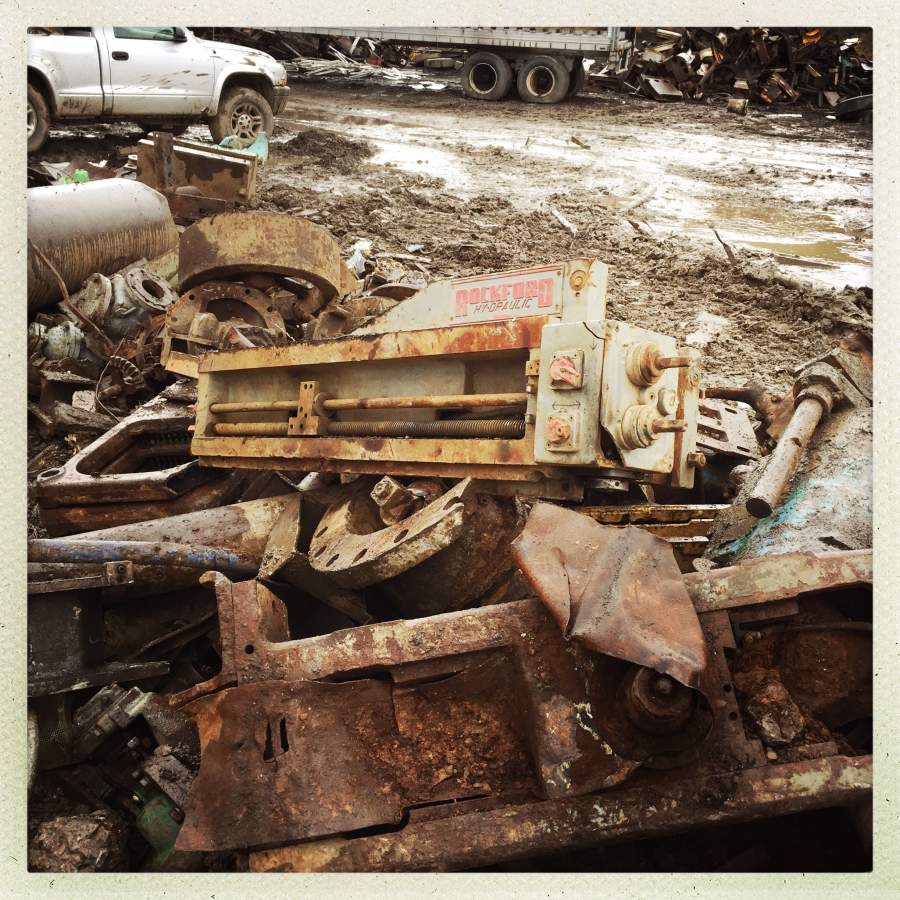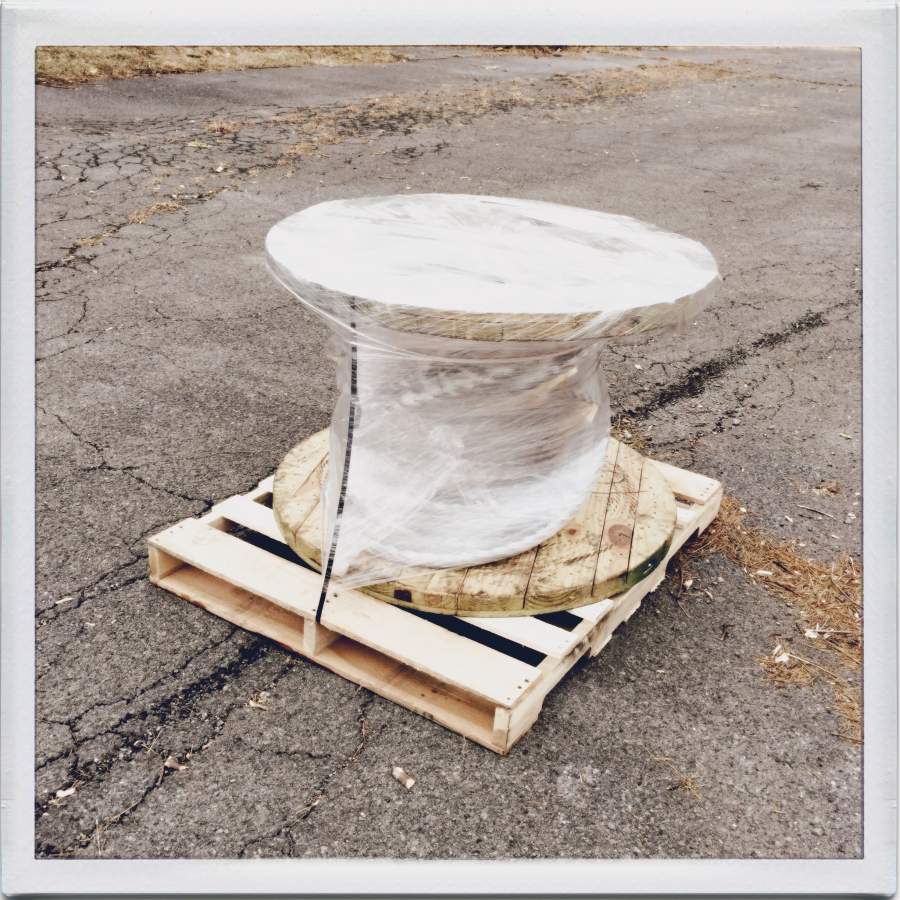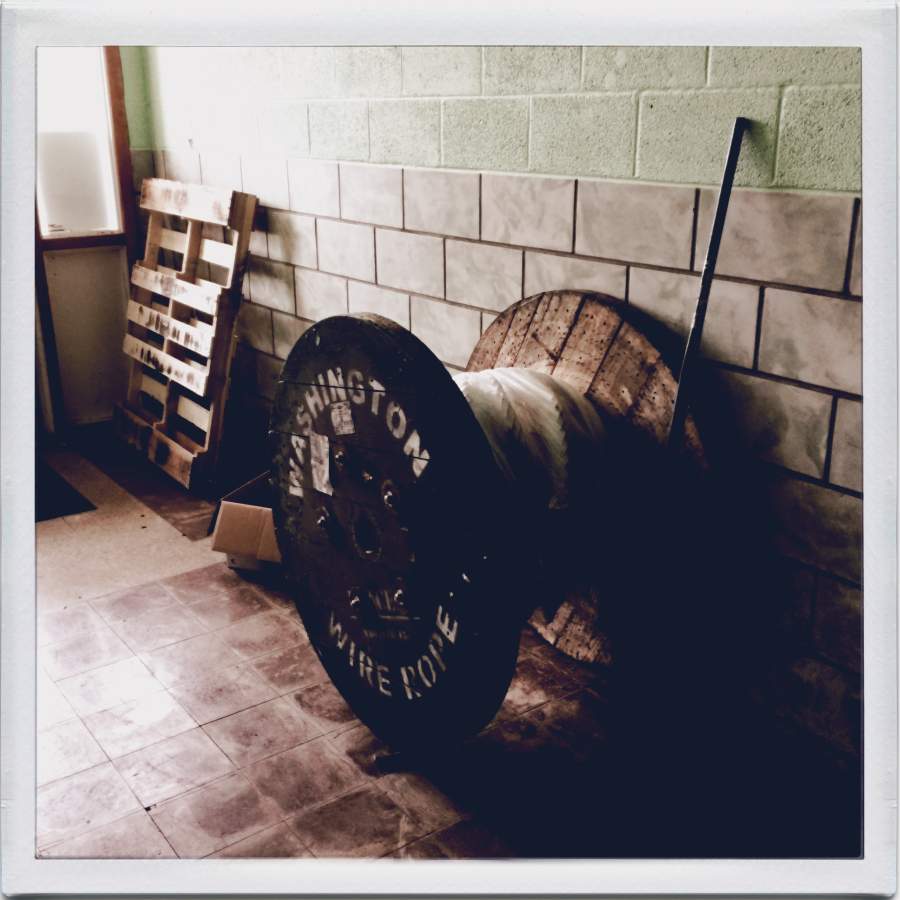I’ve spent a bit of time in search for steel wire rope to weld into sharp, pointy things. It’s been a fun quest. I assumed for a long time that the stuff would be all over the place, up here, because of strip-mining and logging.
It turns out that it’s not, for a reason that was simply explained to me, while I stood in liquid mud up to my knees, by a nice guy with an oxyacetylene torch.
After asking around a bit, everyone I talked to converged on one recommendation: Novey’s.

Noveys is where America’s industrial heartland goes after it has died; it’s a mortuary for bridges, machines, scrap, I-beams, semitrailer bodies, rebar, whatever. I went to the office and asked, and they said “We get cable in sometimes. Go back down the left side, and ask the guy with the white hard hat.”

Once you get past the perimeter the mud gets deeper. As you move through the “aisles” it has mostly been churned to a glue-like consistency about 12″ deep, except for the spots that are about 24″ deep. I found a couple of those and had a chat with the guy in the white hard hat.
He said that cable is a huge pain to deal with on account of its more or less indestructible nature, combined with its flexibility He painted a brief word-picture of chunks of 2″ cable lurking in the mud, waiting to snag the transmission of a bulldozer and rip it out. I found that all quite believable. He said that once it’s been stretched straight, it likes to stay that way, and if you have a bunch of it, the ends will try to stick out and shred anything that snags on them. He said I could grab any chunks I found but, honestly, I just wanted to get out of there. I also had a lot of time to think about “mystery metal” – a lot of blade-smiths will grab stuff from a junkyard and make things out of it, not sure until the last minute if the steel is crap or great material.

I nearly took the gear home; it looks like it’s yummy sand-cast steel, but it might just be cast iron (useless) – the problem was that it weighed about 80lbs and I would have had to carry it back to my car with my arms wrapped around it like a greasy baby, and if I stepped in a deeper mud spot, everyone would be wondering “whatever became of that Marcus guy?”
Besides, cold mud really conducts cold well, and I was starting to go numb below my knees.

That sad-looking piece of metal is what remains of a lathe – once a beautiful piece of precision machinery capable of making other precision machinery with accuracy in the 1/100,000in range. That central screw is yummy high carbon steel, no doubt, but it was rusted immovable and the ways (that’s a single huge casting) was impossibly heavy.
It took me a while to get clean once I got home. One of the things I have never regretted doing, when I renovated the house, was installing an all-weather hot water hose-bib on the side of the house. So, if event of epic mess, one can hose down in a cloud of beautiful steaming hot water (with some home-made soap!) standing out in the yard while it snows.
That was the end of my trip to Novey’s.
Then, I just said “screw this” and called a company that sells wire rope for industrial applications (cranes, boats, elevators, stuff like that) – a nice-sounding guy answered the phone and I said something about being a bladesmith looking for swaged high carbon steel wire rope, 1 and 1/2″ or thereabouts. He said:
“We get a surprising number of calls from your lot.”
He was tremendously helpful and explained that what I wanted was not “drag line wire rope” it was “plow rope” (whatever that is!) and they had plenty of it and he’d really appreciate it if I was not one of those annoying bladesmiths who call up asking for 3 feet of 2″ wire rope. He explained that he, in fact, has a business to run.
I said, I proposed to buy “a lifetime supply” of wire rope, and that meant buying way more than I would probably ever use, so that way I would live a long and tranquil life and die with an impressive supply of wire rope for some frustrated estate-sale agent to deal with. To which he replied:
“Here is the part number: 01096wc637b”
That’s how I wound up getting a call last week from the trucking company, and a nice man delivered a pallet with 75 feet of 1 1/2″ wire plow rope.

I am 57, and I keep coming up with projects that involve things like “move 500lbs of wire rope up a hill, up 2 steps, and into a building.” Naturally, I am optimistic because this thing ought to be a piece of cake after moving the Bridgeport mill.
And, honestly, it was not that bad. It’s on a wheel (you probably noticed that) so once I got it upright using a 6′ steel bar with me hanging on the end, it rolled up to the side of the building with some mere huffing and puffing. I have gotten professional enough at moving big heavy things that I measured it to make sure it would clear the door before I tried to fit it through the door. I had 1″ to work with.
So, Plan A for getting it in the door: roll it back about 20 feet, aim carefully, get up a head of speed and see if it can just go right up the step on its own. Plan B: shine a laser along the flat side of the reel and aim very carefully before trying it. I went with Plan B, which was a bit more effort, but it worked incredibly well! I got up a head of steam and the roll of cable crunched right up the step like it wasn’t there, through the door, and then rocketed off down the hallway of the building – because I couldn’t stop it since I was on the wrong side of the door as it went through. Fortunately, it did not hit anything that mattered but the situation had some great dramatic potential.

I am going to let it rest while I catch my breath.
Which brings me to the “danger” part. The side of the roll against the wall is labeled “DANGER” in letters expressing certainty. I am not sure what is dangerous about this thing, other than parking it on my foot or losing control of it and having it bounce into the street. But I take the DANGER seriously. I wonder if the DANGER is that, if I unwrap it and cut the wire holding the wire rope against the wheel, if it will “unzip” in my face like some kind of spring surprise and I’ll find myself suddenly in a room full of loops of wire rope? Or, what? Perhaps the danger is that I will find it impossible to get the wire rope off the reel with my puny muscles. That would be awkward.
My plan, at this time, is to call the nice fellow at the rigging supply company and let him know that everything got here fine, “but can you tell me what is likely to happen when I unwrap it?”
I can cope with any likely scenario: my current plan is to wait for a cold day and unroll into the parking lot, then practice my oxyacetylene torchmanship by chopping it into 6 foot sections which I can stack someplace where they will not pose a DANGER to anything.

The economics of wire rope are interesting. The stuff is cheap but moving it is expensive. It occurred to me that I could have gotten two lifetimes’ supply and posted a thing on some of the knifemaker bulletin boards “getcher high carbon steel wire rope here!” except then I would be the guy dealing with bladesmiths who want a 6 foot chunk of wire rope. I realized, as I was pushing that damn reel up the hill that I don’t want to handle wire rope any more than the guy at the rigging supply company does, or the guy at Novey’s does. It’s nasty stuff. But so yummy. So, it’s about $10/foot in less than 100 feet. I could have gotten 100 feet for what 75 feet cost me, except then I’d have had a 600lb mass of cable to deal with. Shipping chunks of wire rope around in USPS flat rate boxes would a) amuse me b) piss off the postmarm at Morrisdale post office (I like her and have no desire to have her pissed off at me) c) take a lot of my time d) come with a slight chance of danger, whether in the form of an o/a torch accident, or a chop-saw wheel exploding, or an angle grinder going in my face. If I were going to sell wire rope to bladesmiths at cost I’d lose money on handling and shipping. And if I wanted to break even I’d be selling the stuff for way more than anyone would want to pay for it (“What?! That stuff is $10/foot! I’m not paying $50 for a foot of it!”) I’m afraid that the poor long-suffering friendly guy at the rigging supply company is just going to have to keep dealing with annoying bladesmiths; I will suggest that they only sell in “lifetime supply” quantities.

Huh, didin’t you in some previous episode of Marcus’ DIY rampage mention building a (temporary) ramp to deal with those very same steps? If you’re going to end up buying bulky stuff in bulk maybe you should consider building something more permanent.
Which gives leads me to another suggestion: once the ramp’s in place you could try and build your own custom-spec forklift to fit ramp, door and the corridors you have to navigate. It would be a project and a half, especially since you could add all manner of decorative flourishes, making it a really pretty forklift. (Just don’t forget to make it
prettysafe, too.)That is one impressive junk yard – but kinda sad, in a way. Or maybe, nostalgic.
That wire rope weighs 500 lbs? Yikes. I guess you don’t have a tractor? What komarov says in #1 would be cool: a forklift, because I think one of those would fit inside your building OK. Tractors might be easier to find though, and I believe you can get a set of forks for a bucket and turn it into a pseudo forklift.
It will be interesting to find out what happens when you *do* open up that roll of wire rope. That cable looks mighty anxious to get out of there.
Hope it doesn’t turn out that you really needed drag line wire rope after all…
My tendency in industrial junkyards, and such, is to try to win them to my side. If you win them over you have eyes on the ground who can snag things you like and make connections to other resources. Those guys have resources. That high carbon steel screw thread on the lathe would be easy to burn out with the torch they surely have on hand. That greasy eighty pound gear would be nothing for the forklift to lift and haul to your vehicle. Failing that they would likely let you drive right up to it. It is their place and their rules. Figure out what motivates them. A lot of older guys just want someone to listen. A little ‘hail Roman well met’ and the probable fact that your visit is likely a welcome change of pace means they might be happy to help. Sometimes a bit of cash to help cover the cost of acetylene and diesel might motivate.
I haven’t done knives, discounting a couple of froes (a rough splitting knife), but I have produced some rough tools and jigs. The steel in large industrial vehicle springs is reliably tough and, in my limited experience, hardens and tempers nicely. For years I had a set of heavy leaf springs from a large dump truck or cement mixer. Made quite a few assorted tools before they got left behind in a move.
Axles and driveshafts are also handy. I’ve made a few custom drifts and punches from axle stubs off passenger cars and harvested at the local you-pull junkyard.
For wire rope I would contact someone at a major harbor that deals with rigging on freighters and industrial cranes that load them. Jacksonville Florida has a couple of outfits I hear that deal with wire rope an inch and greater diameter. No doubt that all your major harbors would be likely locations for such outfits. Places like that typically toss out anything that is less than perfect when making assemblies and usually consider lengths under ten foot scrap. A ten or twenty foot off-cut would keep you busy for months.
I maintain a short stack of those cheap folding angle-iron bed frames. They are not suitable for fine work, but handy as hell, for ladder racks, frames and brackets. They are utility-grade, nearly pristine angle-iron available for free because they get tossed out without a thought. The one warning is that the steel is uneven in quality with one piece, or section, being significantly stiffer than others. There is also the rare but memorable inclusion that defies drilling.
I don’t know what the ‘danger’ reference is about but I have seen warnings of wire rope reels put there to remind people that it is scrap and no longer suitable for use as wire rope. Wire rope, or any rope for that matter, can look fine but be internally damaged and dangerous to use unless massively de-rated. Which means very little for your use.
A fine idea.
Scaling up from my experience with control cables for bicycles (thin, max ~6′ lengths) that are shipped loosely coiled, your 75′, tightly coiled much thicker wire rope will straighten rapidly given half a chance. Bicycle cables are just annoying, your wire rope might sting a bit…?
That junk yard is a mixture of sad and potential, I love places like that, I got an old half size pot lab sink for my kitchen from a similar one. The ‘getting the roll into the building’ story made me laugh as it turned out ok, but yes, do find out what the danger is before unpacking the steel wire.
It reminds me a bit of our polyprop roll, which we were given, oh twenty plus years ago. The gas people were relaying the main down our road and towards the end of one day I got a knock on the door, a bloke was stood there with a large tangled bundle of polyprop and said with no preface “Do you want this?”, I said yes and he shoved it into our front room, then left. I set about untangling it, there was metres of the stuff, but I persisted, managing it into a reasonable coil, until I got to the point when I discovered that at underneath the tangled mass was the centre of a large roll, still about 40 cm in diameter of properly wound rope. I’ve no idea how many metres there were, but we’re still using it up and we’ve got maybe 25 cm diameter of roll to go.
“He who dies with the most wire rope wins”
Plan B: shine a laser along the flat side of the reel and aim very carefully before trying it.
Plan C: use a stronger laser, and burn a hole in the wall just the right size to squeeze it in.
Wire rope you say? Shoulda given me a yell, I’m right around the corner from a wire rope place. :)
Don’t forget that there are many different grades, types and designs of wire rope. One shipment may not be enough for you to fully explore your options.
Good luck with that rope. I hope it gets made in to many good blades.
Oh, and on “mystery steel”, my tribulations with the rondel dagger are a clear case why it is not a good idea. I will do it anyway for future projects, simply because it is fun. But if I were to do it for money, I would definitely only work with known steel. And with mystery steel only if it were in a spring.
I’ve been lurking for a while, but don’t think I’ve commented before.
I’ve heard of people using motorcycle chains for pattern welded knives and such, and I imagine part of that they come in a more convenient size.
As to making pattern welded stuff with the cable, would it be noticeable with etching? I was under the impression you needed different types of steel for a pattern to be visible with etching. Are there multiple types of steel making up the strands, or are they all the same?
Danger: is the cabe maybe under tension and does the feather-whipping-in-your-face thing when unpacked?
That junkyard looks like a lot of fun, too bad about the mud.
Your spool of wire also looks like fun. The cartoon kind of fun like when a clock’s springs suddenly explode and go Boinggggggg! Good luck with the unwrapping.
Maybe you should have unwrapped it before moving it inside? I wonder if it’s going to uncoil enough to take out that window, or damage the ceiling?
lochaber@#13:
I’ve heard of people using motorcycle chains for pattern welded knives and such, and I imagine part of that they come in a more convenient size.
Yes, “shurap” on youtube is great at welding up weird things. He’s done some pretty neat stuff including motorcycle chains.
I haven’t been doing stuff like that because: mystery metal. I’m less able to be sure what’s in the chain. I’d rather use nice clean stuff of known provenance. I don’t want to spend a day or two working on a blade and find out it’s crap. This is hard enough when you’re working with knowns.
As to making pattern welded stuff with the cable, would it be noticeable with etching? I was under the impression you needed different types of steel for a pattern to be visible with etching. Are there multiple types of steel making up the strands, or are they all the same?
Yes, When they get welded they appear to retain some patterning of carbon – just discoloration, although it seems as though the welded areas also etch a bit better. I’m not sure why. It makes a very pretty snakeskin pattern.
That makes sense. I would assume that they would make chains out of similar alloys used for gears and/or bearings, and I believe some of them are used in knife making, but that’s a lot of assumptions…
On possible explanation I ran into while googling around is that there may be some minor case-hardening with the strands before forging.
Thanks for the response, and the reminder up on the other post.